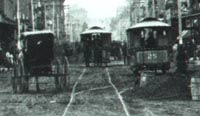
****JavaScript web menu drop down DHTML menu generated by NavStudio. (OpenCube Inc. - http://www.opencube.com)****
|
|
San Diego Bay Timeline The San Diego Historical Society, The San Diego Historical Society,"http://www.sandiegohistory.org" 1885THE ARRIVAL OF THE RAILROAD signaled the end of years of anticipation, delays and disappointment. It also marked a turning point in San Diego 's history. The city was no longer an isolated outpost. Travel coast to coast by train now took only a week. The railroad meant expansion of San Diego 's budding agricultural industry and ready eastern markets for all kinds of produce. Thanks to the region's climate, farmers could raise multiple crops each year. Many San Diegans believed the railroad would also assure the development of the port.Word spread quickly about the potential for investment in San Diego . Get-rich-quick speculators arrived in droves, eager to buy up every available bit of real estate. Land fever caused such frenzy that sometimes the same property sold two or three times over in the same day. The vision for the city as the southwestern terminus for shipping and transportation proved to be short-lived. The boom in real estate was followed by a bust, forcing San Diegans to realize their vision for the city had to be based on a solid economy, not hopeful speculation. San Diegans also realized the city's vulnerability to the whims of the railroad when the Santa Fe abruptly removed its repair and switching yards from National City to San Bernardino. The final blow came next with the Santa Fe's decision to re-route the railroad along the coast and San Diego became the terminus of a spur line from Los Angeles. Following the frenzied Boom and Bust years, San Diegans settled down to plan a more stabilized economy. The city had paid a high price based on get-rich-quick visions. Still determined to establish a commercial port city, San Diegans now worked to build a more up-to-date city with the establishment of city services and public utilities. Modern amenities were important to a growing community. San Diego 's built environment had already begun to change with the construction of buildings and residences typical of those found in big eastern cities.
|
|